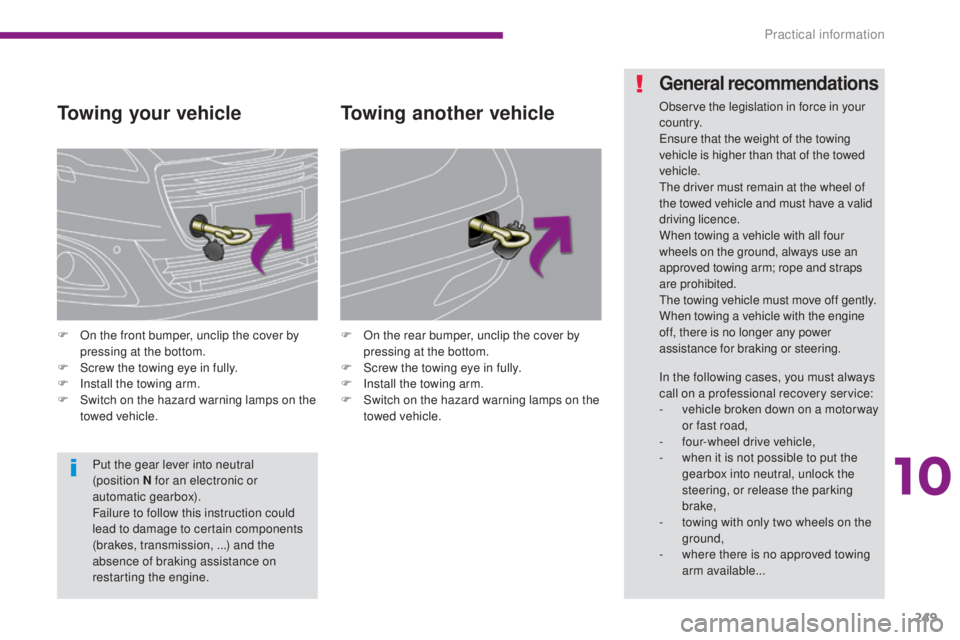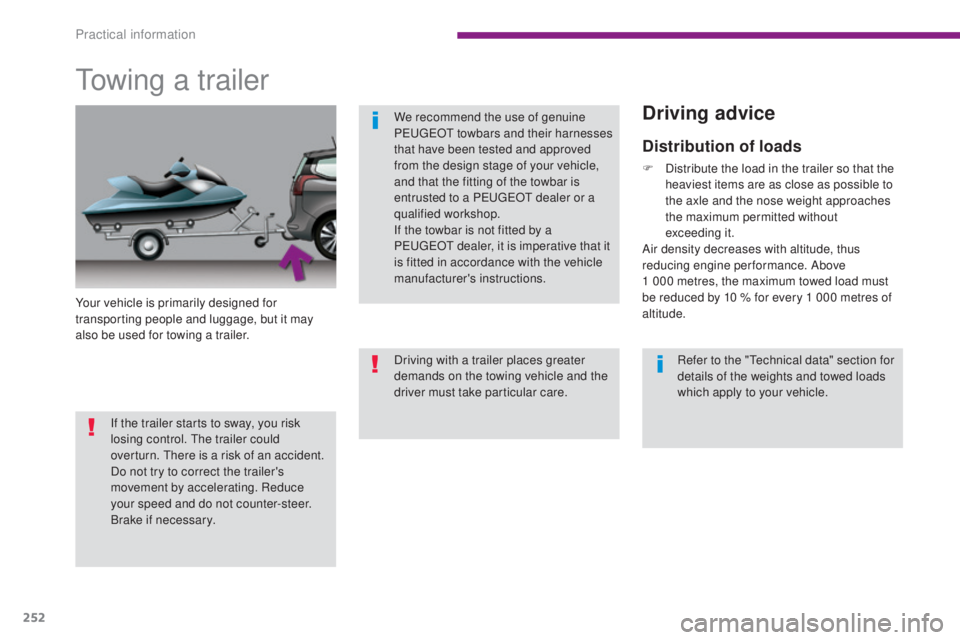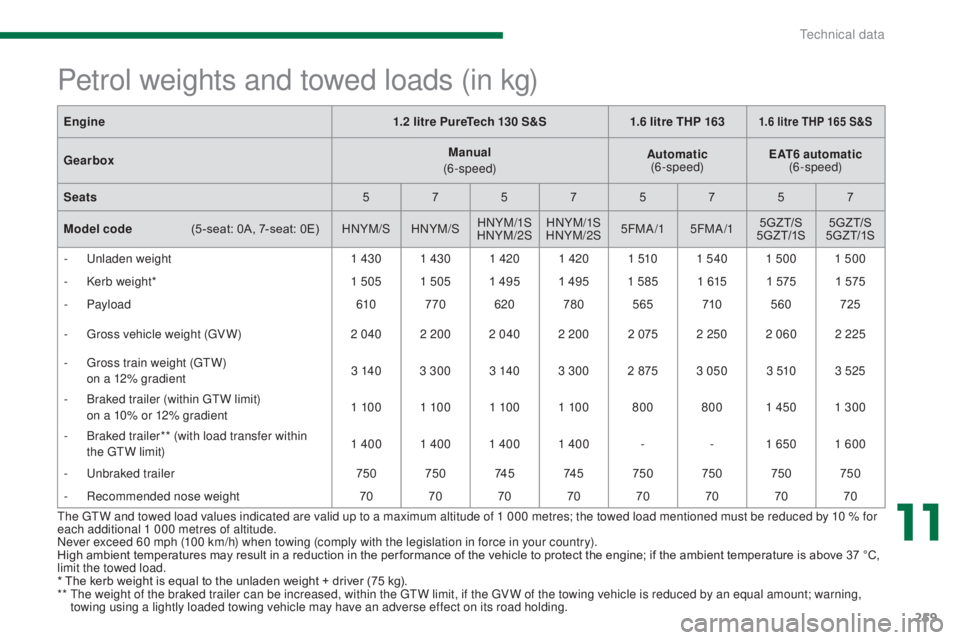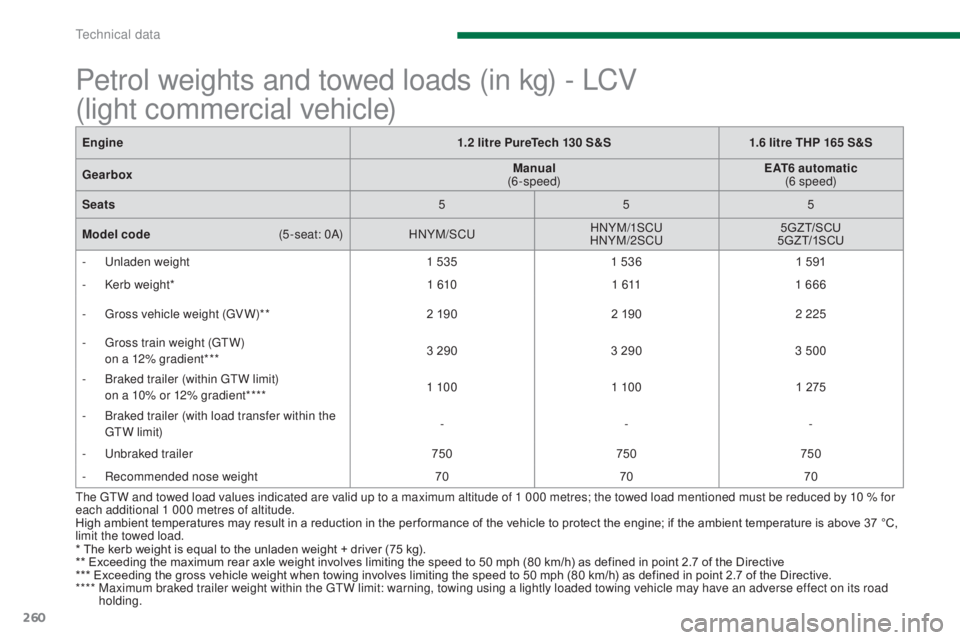Page 238 of 364
236
5008_en_Chap10_infos-pratiques_ed01-2015
F Press the pairs of clips A then B then C to detach the bulb holders.
F
O
pen the boot and remove the upper
tailgate seal.
F
R
emove the centre tailgate trim.
F
U
nscrew the two nuts using a 10
mm
spanner.
F
P
ress the threaded pins while supporting
the lamp from the outside.
F
C
lose the tailgate.
F
D
isconnect the lamp connector then the
screenwash pipe to remove the lens.
Changing the third brake lamp bulb
(5W5)
F Insert a thin screwdriver into one of the outer holes of the lens.
F
P
ush it outwards to unclip.
F
R
emove the lens.
F
P
ull the bulb out and change it.
Changing the number plate lamp
bulbs (W5W)
Practical information
Page 243 of 364
241
5008_en_Chap10_infos-pratiques_ed01-2015
Engine compartment
fuses
The fusebox is placed in the engine
compartment near the battery.Fuse
N° Rating
(A) Functions
F2 15Horn.
F3 10Front / rear wash-wipe.
F4 10Daytime running lamps.
F5 15Purge canister, turbine discharge and Turbo pressure
regulation electrovalves (1.6 litre THP), oil vapour heater
(1.6 litre THP), diesel heater (1.6 litre HDi).
F6 10Diagnostic socket, directional headlamps, particle
emission filter pump (Diesel), Distance alert, mirror
adjustment control.
F7 10Power steering control unit, automatic gearbox, directional
headlamps height adjustment motor.
F8 20Starter motor control.
F9 10Clutch and brake pedal switches.
F11 40Air conditioning fan.
Access to the fuses
F Unclip the cover.
F
C hange the fuse (see corresponding
paragraph).
F
W
hen you have finished, close the cover
carefully to ensure correct sealing of the
fusebox.
Fuse table
10
Practical information
Page 245 of 364
243
5008_en_Chap10_infos-pratiques_ed01-2015
Fuse N° Rating
(A) Functions
F2 5Dual function brake switch.
F3 5Battery charge unit.
F4 25ABS/DSC electrovalves.
F6 15Electronic / automatic gearbox.
Table of fuses above the battery
10
Practical information
Page 251 of 364

249
5008_en_Chap10_infos-pratiques_ed01-2015
Towing your vehicle
F On the front bumper, unclip the cover by pressing at the bottom.
F
S
crew the towing eye in fully.
F
I
nstall the towing arm.
F
S
witch on the hazard warning lamps on the
towed vehicle. F
O n the rear bumper, unclip the cover by
pressing at the bottom.
F
S
crew the towing eye in fully.
F
I
nstall the towing arm.
F
S
witch on the hazard warning lamps on the
towed vehicle.
Towing another vehicle
Put the gear lever into neutral
(position N for an electronic or
automatic gearbox).
Failure to follow this instruction could
lead to damage to certain components
(brakes, transmission,
...) and the
absence of braking assistance on
restarting the engine.
General recommendations
Observe the legislation in force in your
c o unt r y.
Ensure that the weight of the towing
vehicle is higher than that of the towed
vehicle.
The driver must remain at the wheel of
the towed vehicle and must have a valid
driving licence.
When towing a vehicle with all four
wheels on the ground, always use an
approved towing arm; rope and straps
are prohibited.
The towing vehicle must move off gently.
When towing a vehicle with the engine
off, there is no longer any power
assistance for braking or steering.
In the following cases, you must always
call on a professional recovery service:
-
v
ehicle broken down on a motor way
or fast road,
-
f
our-wheel drive vehicle,
-
w
hen it is not possible to put the
gearbox into neutral, unlock the
steering, or release the parking
brake,
-
t
owing with only two wheels on the
ground,
-
w
here there is no approved towing
arm available...
10
Practical information
Page 254 of 364

252
5008_en_Chap10_infos-pratiques_ed01-2015
Towing a trailer
Your vehicle is primarily designed for
transporting people and luggage, but it may
also be used for towing a trailer.Refer to the "Technical data" section for
details of the weights and towed loads
which apply to your vehicle.
We recommend the use of genuine
PEUGEOT towbars and their harnesses
that have been tested and approved
from the design stage of your vehicle,
and that the fitting of the towbar is
entrusted to a PEUGEOT dealer or a
qualified workshop.
If the towbar is not fitted by a
PEUGEOT dealer, it is imperative that it
is fitted in accordance with the vehicle
manufacturer's instructions.
Driving with a trailer places greater
demands on the towing vehicle and the
driver must take particular care.
If the trailer starts to sway, you risk
losing control. The trailer could
overturn. There is a risk of an accident.
Do not try to correct the trailer's
movement by accelerating. Reduce
your speed and do not counter-steer.
Brake if necessary.
Driving advice
Distribution of loads
F Distribute the load in the trailer so that the heaviest items are as close as possible to
the axle and the nose weight approaches
the maximum permitted without
exceeding
it.
Air density decreases with altitude, thus
reducing engine performance. Above
1
000 metres, the maximum towed load must
be reduced by 10
% for every 1 000 metres of
altitude.
Practical information
Page 255 of 364

253
5008_en_Chap10_infos-pratiques_ed01-2015
Side wind
F Take into account the increased sensitivity to side wind.
Cooling
Towing a trailer on a slope increases the
temperature of the coolant.
As the fan is electrically controlled, its cooling
capacity is not dependent on the engine speed.
F
T
o lower the engine speed, reduce your
speed.
The maximum towed load on a long incline
depends on the gradient and the ambient
temperature.
In all cases, keep a check on the coolant
temperature.
Braking
Towing a trailer increases the braking distance.
To avoid overheating of the brakes on a long
mountain type of descent, the use of engine
braking is recommended.
Ty r e s
F Check the tyre pressures of the towing vehicle and of the trailer, observing the
recommended pressures.
Lighting
F Check the electrical lighting and signalling on the trailer.
The rear parking sensors will be
deactivated automatically if a genuine
PEUGEOT towbar is used.
F
I
f the warning lamp and the
STOP
warning lamp come on, stop the
vehicle and switch off the engine as
soon as possible.
10
Practical information
Page 261 of 364

259
5008_en_Chap11_caracteristiques_ed01-2015
* The kerb weight is equal to the unladen weight + driver (75 kg).
** T he weight of the braked trailer can be increased, within the GTW limit, if the GV W of the towing vehicle is reduced by an equal amount; warning,
towing using a lightly loaded towing vehicle may have an adverse effect on its road holding.
Engine
1.2 litre PureTech 130 S&S1.6 litre THP 163
1.6 litre THP 165 S&S
Gearbox Manual
(6-speed) Automatic
(6-speed) EAT6 automatic
(6-speed)
Seats 57575757
Model code
(
5 -seat: 0A, 7-seat: 0E) HNYM/S HNYM/SHNYM/1S
HNYM/2S HNYM/1S
HNYM/2S 5FMA /1 5FMA /1 5G Z T/S
5G Z T/1S 5G Z T/S
5G Z T/1S
-
U
nladen weight 1 430 1 4301 420 1 420 1 5101 540 1 500 1 500
-
K
erb weight* 1 505 1 5051 495 1 4951 5851 6151 575 1 575
-
Payload 610770 620 780565 710560 725
-
G
ross vehicle weight (GV W) 2 040 2 200 2 040 2 200 2 0752 250 2 060 2 225
-
G
ross train weight (GTW)
o
n a 12% gradient 3 140
3 300 3 1403 300 2 8753 050 3 5103 525
-
B
raked trailer (within GTW limit)
o
n a 10% or 12% gradient 1 10 0 1 10 0 1 10 0 1 10 0
800 8001 450 1 300
-
B
raked trailer** (with load transfer within
the GTW limit) 1 400 1 400 1 400 1 400 -
- 1 650 1 600
-
U
nbraked trailer 750 75074 5 74 5750 750 750 750
-
R
ecommended nose weight 70 70 70 70 70 70 70 70
The GTW and towed load values indicated are valid up to a maximum altitude of 1 000 metres; the towed load mentioned must be reduced by 10 % for
each additional 1 000 metres of altitude.
Never exceed 60 mph (100 km/h) when towing (comply with the legislation in force in your country).
High ambient temperatures may result in a reduction in the per formance of the vehicle to protect the engine; if the ambient temperature is above 37 °C,
limit the towed load.
Petrol weights and towed loads (in kg)
11
Technical data
Page 262 of 364

260
5008_en_Chap11_caracteristiques_ed01-2015
Petrol weights and towed loads (in kg) - LCV
(light commercial vehicle)
* The kerb weight is equal to the unladen weight + driver (75 kg).
** Exceeding the maximum rear axle weight involves limiting the speed to 50 mph (80 km/h) as defined in point 2.7 of the Directive
*** Exceeding the gross vehicle weight when towing involves limiting the speed to 50 mph (80 km/h) as defined in point 2.7 of the Directive.
****
M
aximum braked trailer weight within the GTW limit: warning, towing using a lightly loaded towing vehicle may have an adverse effect on its road
holding.
The GTW and towed load values indicated are valid up to a maximum altitude of 1 000 metres; the towed load mentioned must be reduced by 10 % for
each additional 1 000 metres of altitude.
High ambient temperatures may result in a reduction in the per formance of the vehicle to protect the engine; if the ambient temperature is above 37 °C,
limit the towed load. Engine
1.2 litre PureTech 130 S&S1.6 litre THP 165 S&S
Gearbox Manual
(6-speed) EAT6 automatic
(6 speed)
Seats 555
Model code
(
5-seat: 0A)
HNYM/SCU HNYM/1SCU
HNYM/2SCU 5GZT/SCU
5G Z T/1SCU
-
U
nladen weight
1 5351 536 1 591
-
K
erb weight*
1 6101 6 111 666
-
G
ross vehicle weight (GV W)**
2 1902 1902 225
-
G
ross train weight (GTW)
o
n a 12% gradient***
3 290
3 2903 500
-
B
raked trailer (within GTW limit)
o
n a 10% or 12% gradient****
1 10 0
1 10 0 1 275
-
B
raked trailer (with load transfer within the
GTW limit) -
--
-
U
nbraked trailer
750750750
-
R
ecommended nose weight
707070
Technical data